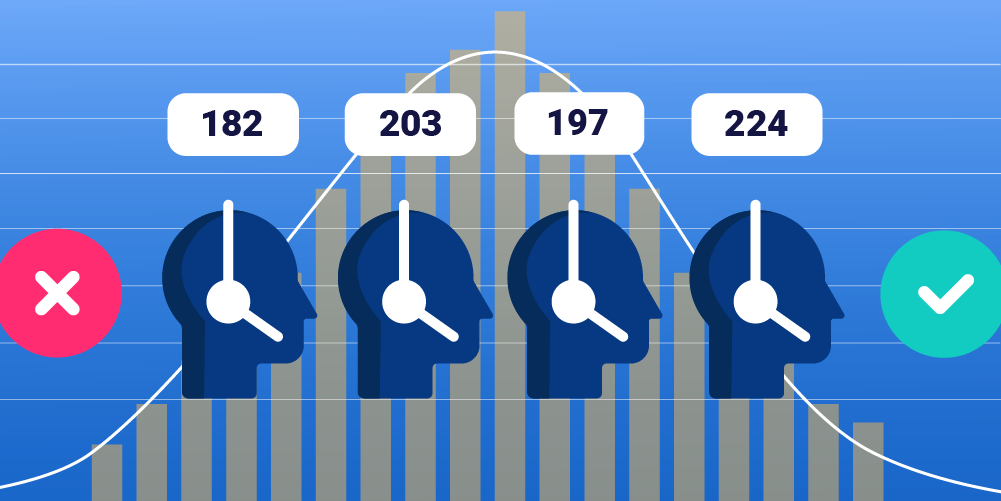Average handling time (AHT) is something of a Cinderella topic in the world of workforce planning. It’s just not exciting. When AHT does get mentioned, it’s normally in the context of reducing the amount of time spent on customer interactions to increase productivity. Reducing AHT is a good thing, right? Not necessarily. You can’t drive it down without potentially impacting quality. This can literally be a matter of life and death - for example in the emergency services.
I’d like to argue that average handling time deserves more attention than it typically gets. Here are some dos and don’ts to bear in mind when managing AHT in your contact center.
Do
- Do realize that AHT is not a key performance indicator (KPI). I know that sounds controversial, but it’s easy to fall into the trap of managing what you can easily measure. In most call centers, AHT is readily available via the ACD, routing platform, or WFM application. AHT is crucial because it affects outcomes such as service level, required staffing levels, operating costs, and call quality. You need to monitor it constantly. But by itself, it isn’t a KPI.
- Do put as much attention into forecasting AHT as you put into forecasting contact volumes. Forecasting is the cornerstone of planning. Staffing calculation is a function of both volume and AHT, so if you get AHT wrong, your whole planning process will be undermined.
- Do create benchmarks. Use the AHT of one or more ‘ideal’ agents as a standard. Find one or more agents who perfectly balance AHT with quality. That won’t necessarily be the agent with the shortest average handling time. It could be one whose AHT is 10% longer than the team average but whose quality scores or sales figures are routinely 20% better than the team average.
- Do be realistic about the AHT goals that you assign to individual agents. AHT can’t be ‘one size fits all’. In reality, the AHT of your agent population will follow a Normal distribution or ‘bell curve’. It’s a good idea to divide your agents into 3 tiers: starters, fully trained, and top performers. For each tier, you should have an allowed AHT range. You’ll never reach the nirvana of every agent being at the ‘top performer’ level. Even with low turnover, there will always be people who have room for coaching and improvement.
- Do remember that AHT varies by time of day, day of week, and so on. Evening calls typically last longer than calls during the working day because customers aren’t then under the same time pressure. Calculating required staffing using a fixed AHT will almost certainly lead to periods of under- and over-staffing, which reduces customer satisfaction and increases agent stress levels. Good WFM applications automatically forecast varying AHT and calculate staffing levels accordingly.
- Do periodically check your handling time data for outliers. Imagine you are experiencing a high volume of very short calls due to a technical issue. If those very short calls are included in the AHT calculation, the result will underestimate the true AHT. You should be able to get a report showing the distribution of handling times from your ACD or contact routing platform.
- Do run test calls. It’s a mistake to assume that a given average handling time is achievable without validation. It’s much better to run some role-playing tests and fail during a simulation than to implement an AHT that is certain to lead to annoyed customers and burned-out agents.
Don't
- Don’t assume that historical AHT is an indicator of future AHT. If you’ve taken initiatives to streamline calls, AHT may go down. If you want to improve quality or if you’ve increased prices, it may go up. You should always use recent history when forecasting AHT. And you should be proactive in gathering intelligence about upcoming changes, so you can factor these into the calculation.
- Don’t forget that AHT is a function of staff turnover. High staff turnover not only increases recruitment and training costs but also increases AHT. If you take steps to improve agent engagement and well-being, you will reduce turnover and therefore reduce AHT.
- Don’t believe that the obvious AHT wins have already been implemented. For example, why ask customers to provide information during the call that they already entered using interactive voice response (IVR)? It sounds obvious, but this mistake is more common than many people realize. And it really annoys customers.
- Don’t be afraid to admit that longer average handling time leads to improved KPI outcomes. If you can produce sound numerical evidence that longer AHT leads to better performance on the metrics that matter, you will have a fighting chance of winning the budget necessary to staff up to the optimum AHT.
Did you find the article interesting and would like to share it with your colleagues? Download the article as a PDF.





